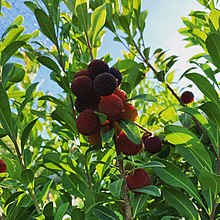Myrica rubra
| Myrica rubra | |
|---|---|

| |
| Myrica rubra grown in Fremont, California | |
| Scientific classification | |
| Kingdom: | Plantae |
| Clade: | Tracheophytes |
| Clade: | Angiosperms |
| Clade: | Eudicots |
| Clade: | Rosids |
| Order: | Fagales |
| Family: | Myricaceae |
| Genus: | Myrica |
| Species: | M. rubra
|
| Binomial name | |
| Myrica rubra | |
| Synonyms | |
Myrica rubra, also called yangmei (simplified Chinese: 杨梅; traditional Chinese: 楊梅; pinyin: yángméi; Cantonese: yeung4 mui4; Shanghainese: [ɦiɐ̃².mɛ⁴]), yamamomo (Japanese: ヤマモモ), Chinese bayberry, red bayberry, yumberry, waxberry, or Chinese strawberry (and often mistranslated from Chinese as arbutus) is a subtropical tree grown for its fruit.
Description
Myrica rubra is an evergreen tree that grows to a height of up to 10–20 m (33–66 ft) high, with smooth gray bark and a uniform spherical to hemispherical crown. Leaves are leathery, bare, elliptic-obovate to oval lanceolate in shape, wedge-shaped at the base and rounded to pointed or tapered at the apex, margin is serrated or serrated in the upper half, with a length of 5–14 cm (2.0–5.5 in) and a width of 1–4 cm (0.39–1.57 in). Leaves are alternately arranged on the branches are divided into petiole and leaf blade. The petiole is 2–10 mm (0.079–0.394 in) long. The leaf underside is pale green and sparsely to moderately golden glandular, the top surface is dark green.[1]
The species is
Female inflorescences are single with multi-flowered spikes of 0.5–1.5 cm (0.20–0.59 in)in length standing in the leaf axils. The rhachis is hairy and glandular. The cover sheets overlap, are hairless and only unobtrusively glandular. Female flowers are accompanied by four leaves. The upper ovary is velvety hairy, with a stylus with a two-lobed scar. There are two slender scar lobes that are colored bright red.
The flowering period extends from March to April in China, with fruits developing from May to June. The fruit is spherical, typically 1.5–2.5 cm (0.6–1 in) in diameter, with diameters up to 3 centimeters, a knobby surface. The surface is a thick-skinned, typically a crimson red, but may vary from white to purple, with similar or somewhat lighter flesh color. At the center is a single seed, with a diameter about half that of the whole fruit. The flesh is sweet and very tart.
-
Flowers
-
Fruit
-
Leaves
-
Tree
-
Ripe Fruit
Taxonomy
The plant was first described by João de Loureiro in Flora Cochinchinensis, 2, page 548 in 1790 under the name (basionym) Morella rubra [2] The species was moved to the genus Myrica as Myrica rubra (Lour.) Siebold & Zucc. by Philipp Franz von Siebold and Joseph Gerhard von Zuccarini in treatises of the Bavarian Academy of Sciences. Mathematical and natural science class, volume 4, number 3, page 230 published.
In studies of
Chromosome count is 2n = 16[5]
Distribution and habitat
It is native to eastern Asia, mainly in south-central China in province of Fujian, Guangdong, Guangxi, Guizhou, Hainan, Hunan, Jiangsu, Jiangxi, Sichuan, Yunnan, and Zhejiang; Japan, Korea, and the Philippines in forests on mountain slopes and valleys at elevations of 100–1,500 metres (330–4,920 ft).[1] Seeds are dispersed by Japanese macaques[6] and Yakushima macaques.[7]
Cultivation


Chinese cultivation is concentrated south of the
It tolerates poor acidic soils. The root system is 5–60 cm (2.0–23.6 in) deep, with no obvious taproot.
Myrica rubra was first introduced into the United States by
The tree is used as
Products
Some
In the
Other uses include
- bottled pasteurized juiceor juice blends
- dye prepared from the bark
- yogurt flavoring
- blended preserves
Research and phytochemicals
Various species of Myrica have been studied scientifically for
- nitrogen-fixing ability of the root nodules system[17]
- presence of Frankia bacteria having nitrogen-fixing properties in root nodules[18][19]
- subcanopy soil[20]
- niche characteristics in the forest environment[21]
- growth of pollen tubes[22]
Cultural significance
Archaeological and written evidence suggest that yangmei cultivation first took place in China over 2,000 years ago during the
In Japan, it is the prefectural flower of Kōchi and the prefectural tree of Tokushima. The plant's name appears in many old Japanese poems.
References
- ^ a b "Myrica rubra in Flora of China @ efloras.org". eFloras.org Home. 2000-06-09. Retrieved 2020-07-30.
- ^ Loureiro, João de; Lisboa., Academia das Ciências de (1790). Flora cochinchinensis. Vol. v.2. Retrieved 2020-07-30.
{{cite book}}:|website=ignored (help) - ^ ISSN 0018-5345.
- ^ PMID 25986380.
- ^ "Name - Myrica rubra (Lour.) Siebold & Zucc". Tropicos. 2020-07-30. Retrieved 2020-07-30.
- S2CID 40025805.
- S2CID 1265349.
- S2CID 44569467.
- ^ Bulletin of Foreign Plant Introductions. 1918. p. 1522-IA2. Retrieved 2020-07-30.
- ^ Journal of the Washington Academy of Sciences. Washington Academy of Sciences. 1922. p. 275. Retrieved 2020-07-30.
- ^ "Calmei". Calmei.
- ^ "Yum's the word". California Bountiful. 2012-03-27. Retrieved 2020-07-30.
- ^ OCLC 223913003. Retrieved 23 June 2009.
- ^ Karp, David (12 December 2007). "From China, Only in a Bottle, a Berry With an Alluring Name". The New York Times. Retrieved 14 September 2018.
- ISBN 9786214200870.
- ^ "Tsampoy". Tagalog Lang. Retrieved 1 November 2021.
- PMID 16663881.
- PMID 11319089.
- PMID 15344928.
- PMID 1605919.
- PMID 12722433.
- PMID 16291781.
- ^ Wende, Meng Meng. "Ancient and Modern Yangmei Poems". Douban. Retrieved 14 September 2018.
External links
 Media related to Myrica rubra at Wikimedia Commons
Media related to Myrica rubra at Wikimedia Commons Data related to Myrica rubra at Wikispecies
Data related to Myrica rubra at Wikispecies





